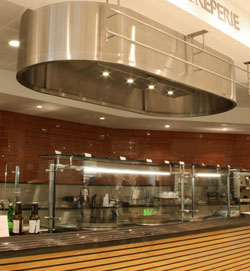Quiet Kitchen Ventilation Fans
When choosing the right ventilation solution for your modern kitchen, you have to select one from a set of energy-efficient and quiet kitchen ventilation fans. Thus, you have to look for manufacturers and distributors of ventilation fans with high energy efficiency and low-noise rating. These parameters take the opposite ends of the performance spectrum, and the main challenge is to find the best middle ground where you get the power rating that matches the requirements of your kitchen without getting a sound rating that is a bit too high.
Ventilation System of Modern Kitchens
Most ventilation systems in modern kitchens consist of quiet kitchen ventilation fans, exterior hoods and ducting. Some of the modern homes today are now equipped with a central ventilation system, where a single ventilation fan draws stale and humid air and odors from the bathroom, kitchen, garage and other rooms through a network of ducts.
Other kitchen ventilation systems make use of inline fans and or exhaust fans that are installed outside of the house. Outdoor and inline exhaust devices are the better alternatives to exhaust fans installed inside the home when you are looking for quiet kitchen ventilation fans.
Additionally, you must also remember that kitchen ventilation fans will have to handle more air than the exhaust fans installed in the bathroom. Thus, you have to carefully consider the CFM rating of the ventilation device that you are going to choose. This means that you might have to choose ventilation fans that have higher noise rating.
Essential Features of Quiet Kitchen Ventilation Fans
An ideal exhaust device for the kitchen must have the following important features:
- Move air from 100 to 300 CFM
- Lowest sound rating of 4.5 sones
- Sound insulation
- Duct connections
- Anti-vibration mounts
Factors that Affect the Sound Level
The level of the operating sound of ventilation fans can be significantly affected by the following:
- Duct size
- Total area of the hood filter of the kitchen exhaust system
- Design and Type of the grease filter
- Number and distance of the turns of the ducting
Duct Size
Kitchen exhaust systems with ducting with smaller diameter generate greater sound. Thus, it is important that you use the minimum duct size that is recommended by the manufacturer. You must also remember that CFM and sound level is directly proportional. This means that the sound created by the moving air becomes louder as the CFM rating of the kitchen ventilation fan becomes higher.
Filter Size and Area
Typically, quiet kitchen ventilations fans will have filters along the bottom of the hood with bigger size and area. The area of the filter is usually reduced by the presence of space panels or filler materials between them. As these components eat up a lot of space, they also increase the operating sound level of the ventilation system.
Design of the Grease Filter
Quiet kitchen ventilation fans are the mechanical devices that are outfitted with filters that have bigger openings. You must remember that the size of the filter opening is inversely related to the operating sound level of the exhaust system.
Duct Work
Quiet kitchen ventilation fans usually have round ducting and the turns of the ducting have round elbows that are smooth. The elbows must not be set close to each other as this does not only affect the efficiency of the ventilation fan but increases the sound level as well.

Categories
- Home
- Types Of Kitchen Ventilation Fan
- Commercial Kitchen Ventilation Equipment
- Industrial Kitchen Ventilation Fans
- Island Kitchen Ventilation Fan
- Kitchen Roof Ventilation Fan
- Kitchen Ventilation Fan Units
- Kitchen Wall Ventilation Fan
- Oscillating Wall Kitchen Ventilation Fan
- Quiet Kitchen Ventilation Fans
- Through Wall Kitchen Exhaust Fan
- Under Cabinet Kitchen Ventilation Fan
- Wall Mount Kitchen Ventilation Fan
- Kitchen Ventilation Fan Information
- Kitchen Ventilation Fan Ranges And Styles
